General Performance
Starting out with the overall system performance benchmarks, we have PCMark05, 3DMark03/05/06, and a couple 3D rendering tests. We will also include the CPU results from the 3DMark applications. Note that 3DMark05/06 have multithreaded CPU tests, while 3DMark03 does not.
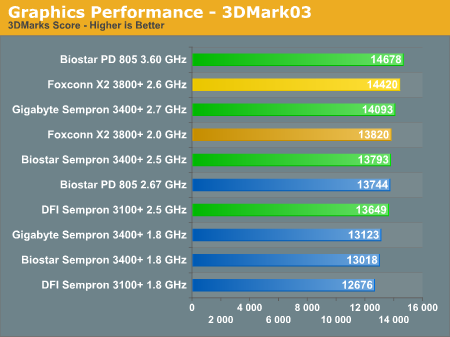

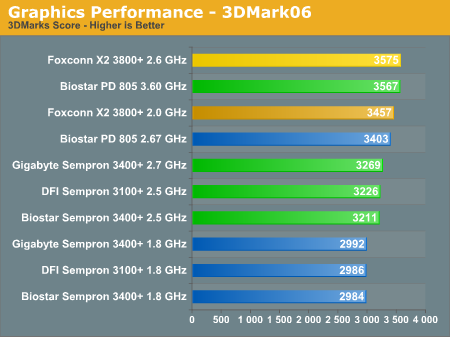

The Pentium D 805 makes an immediate impression as a high-performance budget offering. The margins in 3DMark are not very large, but the Pentium D comes out ahead in all three benchmarks, both at stock speeds and when overclocked. Given that PCMark05 includes several multitasking tests, the greater margin of victory isn't too surprising. However, even if the results are somewhat expected, it does not change the fact that the Pentium D makes a great budget setup for anyone that does moderate amounts of multitasking. If we consider the X2 3800+, it comes out ahead of the Pentium D 805 at stock clock speeds, but overclocking -- at least with this particular graphics card -- results in a dead heat.
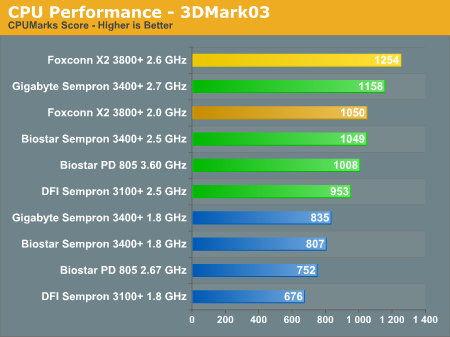
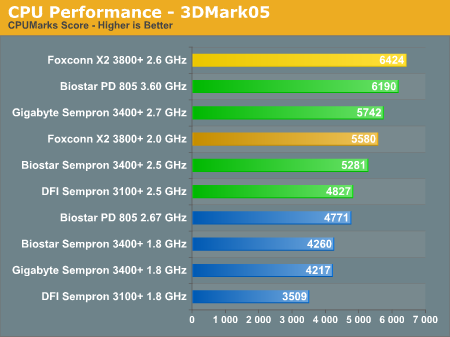
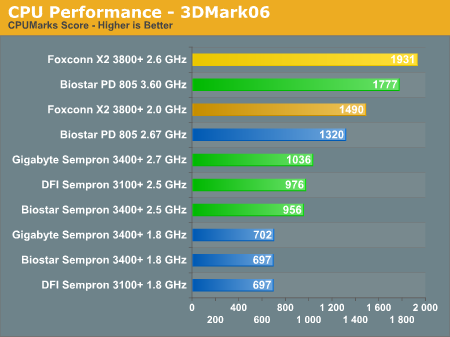
Looking at the 3DMark CPU results, things begin to spread out quite a bit. The X2 3800+ easily leads in these benchmarks, in both stock and overclocked configurations. If we ignore the X2 chip, the Pentium D 805 has a commanding lead in the multithreaded 3DMark05/06, while it trails several of the other systems in 3DMark03. We always mention how 3DMark is really a synthetic graphics benchmark as opposed to real gaming benchmarks, and the same applies to the CPU benchmarks within the 3DMark applications. They show the potential your CPU has to outperform other processors under certain situations, but whether or not real applications perform similarly is going to depend on many factors. Dual core systems definitely have more potential performance, but unfortunately the vast majority of games remain single threaded applications.
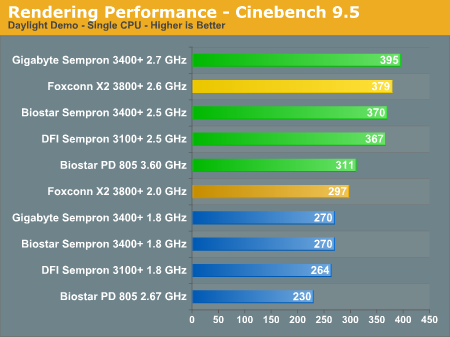
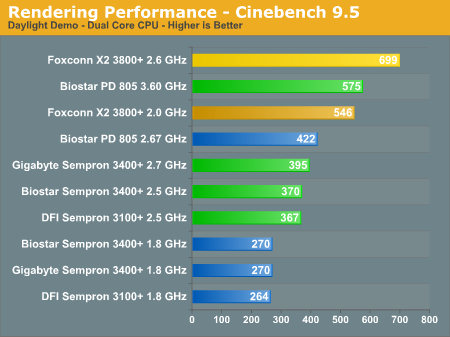

Shifting over to 3D rendering, the Sempron systems are able to do quite well in the single threaded rendering tests. Once SMP support is enabled in Cinebench, the 83% performance increase that the Pentium D and X2 gain easily eclipses the other offerings. POV-Ray also seems to like the NetBurst architecture as the result from our overclocked Pentium 805 is at the top of the chart. It's unfortunate that POV-Ray doesn't support multiple processors, but we could say the same thing about many other applications.
Starting out with the overall system performance benchmarks, we have PCMark05, 3DMark03/05/06, and a couple 3D rendering tests. We will also include the CPU results from the 3DMark applications. Note that 3DMark05/06 have multithreaded CPU tests, while 3DMark03 does not.




The Pentium D 805 makes an immediate impression as a high-performance budget offering. The margins in 3DMark are not very large, but the Pentium D comes out ahead in all three benchmarks, both at stock speeds and when overclocked. Given that PCMark05 includes several multitasking tests, the greater margin of victory isn't too surprising. However, even if the results are somewhat expected, it does not change the fact that the Pentium D makes a great budget setup for anyone that does moderate amounts of multitasking. If we consider the X2 3800+, it comes out ahead of the Pentium D 805 at stock clock speeds, but overclocking -- at least with this particular graphics card -- results in a dead heat.



Looking at the 3DMark CPU results, things begin to spread out quite a bit. The X2 3800+ easily leads in these benchmarks, in both stock and overclocked configurations. If we ignore the X2 chip, the Pentium D 805 has a commanding lead in the multithreaded 3DMark05/06, while it trails several of the other systems in 3DMark03. We always mention how 3DMark is really a synthetic graphics benchmark as opposed to real gaming benchmarks, and the same applies to the CPU benchmarks within the 3DMark applications. They show the potential your CPU has to outperform other processors under certain situations, but whether or not real applications perform similarly is going to depend on many factors. Dual core systems definitely have more potential performance, but unfortunately the vast majority of games remain single threaded applications.



Shifting over to 3D rendering, the Sempron systems are able to do quite well in the single threaded rendering tests. Once SMP support is enabled in Cinebench, the 83% performance increase that the Pentium D and X2 gain easily eclipses the other offerings. POV-Ray also seems to like the NetBurst architecture as the result from our overclocked Pentium 805 is at the top of the chart. It's unfortunate that POV-Ray doesn't support multiple processors, but we could say the same thing about many other applications.










56 Comments
View All Comments
Calin - Wednesday, July 12, 2006 - link
We were promised reviews of micro ATX mainboards a while back (hopefully with integrated video performance too, dual and single channel :) ). The article should be in the works now.Anyway, none of the integrated graphics/microATX boards I looked upon (from MSI, Asus etc) did have anything in the way of overclocking/overvolting/undervolting/...
I'm waiting, thanks
Rix2357 - Monday, July 10, 2006 - link
Most of these motherboards are decently cheap, but I wonder if they are as stable as some more well established brands. Of course, I go way back and a mantra that I've heard over and over, for stability Asus and Intel motherboards are the only way to go. While the DFI board in the test could be reasonably expected to be relatively stable, I am unsure about the biostar motherboard.My case in point from way back. The ECS K7S5A motherboard for a Socket A Athlon motherboard was supposedly one of the best, but it still had it's quirks. It's no where near as stable as the Asus Williamete motherboard at that time. It also has cold boot issues that numerous different bioses have never fixed. Hard drive detection with a third party IDE controller could be problematic at best.
Calin - Wednesday, July 12, 2006 - link
I have an ECS K7S5A mainboard, and its stability was good. Anyway, that was around the time when even top mainboards had one or two errors in 72 hours of benchmarks/stability checks.I would say Gigabyte boards are good too - I've had not so positive experiences with Foxconn boards.
JarredWalton - Monday, July 10, 2006 - link
The Biostar + PD805 has been in use for roughly six months, without any noticeable problems. The DFI Infinity has also been in use for a while without problems. AM2 is too new to say how it is in terms of stability, but I definitely enjoy the extra features (because I am one of those people that has GbE running through the house). If your primary concern is stability, you'd probably want to skip out on overclocking anyway. One of the biggest difficulties in overclocking is determining long-term "stable" settings. It can take months to get what you feel is an optimally stable system, and minor tweaks to voltages, memory timings, bus speeds, etc. can turn a crash-prone system fully stable (or vice versa).Avalon - Monday, July 10, 2006 - link
If these are budget considerations, why is 2-2-2 DDR memory and an XXX XFX listed in there? You can get an eVGA 7600GT CO for less than $150AR from time to time, and 1GB of CAS 2.5 memory will only set you back $90 and be practically as fast. That's $60 saved.Gary Key - Monday, July 10, 2006 - link
Jarred explained this on page 2. The memory selected for the S754 system is what we had available at the time for 2-2-2 operation. You are right that additional money could be saved for a minor performance delta. Since this article was looking at budget gaming performance, the XFX video card was chosen since it was still in our price range and is factory overclocked allowing a small increase in performance for those uncomfortable with overclocking the GPU. We mentioned that with rebates just about any of the 7600GT cards could be had for around $140~$160.
This article was designed to provide an umbrella look at what is available in the $650 price range and how it performs with today's game titles. We certainly understand that additional money could be saved or could be spent depending upon the individual's objective in building a system. As an example, on the S754 system you could have spent a little less on the memory but could have taken those savings and applied them to a better audio solution resulting in the same end figure. Some people would rather have the improved memory performance and live with the on-board audio. In the end, for about $650 you can build a decent machine today and there are an incredible amount of component choices that allow you to do this.